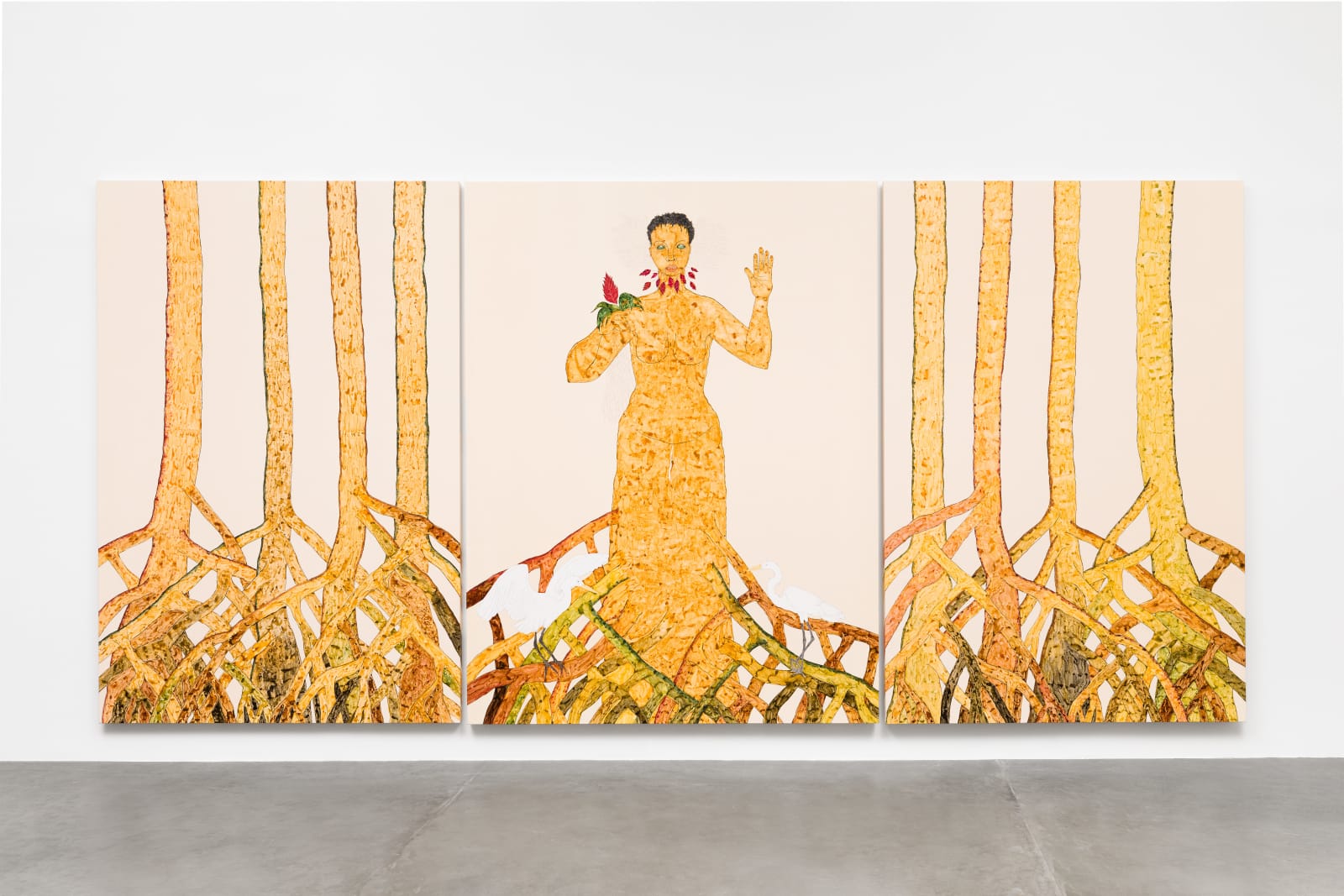Rosana Paulino
Garça branca, Da série mangue, 2023
graphite, acrylic and natural pigment on canvas
grafite, acrílica e pigmento natural sobre tela
grafite, acrílica e pigmento natural sobre tela
267 x 559 cm
105 1/8 x 220 1/8 in
105 1/8 x 220 1/8 in
This last series, Mangrove, is a continuation of the Jatobás idea. I go deeper and deeper into the environment, into the Brazilian biomes, thinking of this tree-woman as if she...
This last series, Mangrove, is a continuation of the Jatobás idea. I go deeper and deeper into the environment, into the Brazilian biomes, thinking of this tree-woman as if she was even older, more archetypical. A friend of mine says the Mangrove women are grandmothers of the Jatobás’ grandmothers. It’s like deeming the human being incapable of conceiving an archetype alone, a person alone cannot envision what it is to build an archetype by himself or herself. But within this thought of bringing the woman to Brazilian nature, it’s about further strengthening this relationship, seeking the possibility of ideating this psychology. As well, considering that Brazilian nature was completely refused, mistreated, dilapidated, destroyed, and exploited, just like the black and indigenous people. So I’ll be after getting closer to this Brazilian woman and this Mangrove biome, considering the possibilities in mythology, archetypes, and wisdom. For as I carried out this work with the trees, with the Brazilian environments, with the woods, with the vegetation, I started realizing that maybe those who hold the key to saving the human species are notably these underrated ones. Quilombolas, riverside residents, indigenous people, those in the candomblé houses…
I chose the Mangrove because it’s an environment I like very much due to the aerial roots which are interconnected, one depends on the other, a biome where everything begins and ends. It is a biome full of symbolic meanings, a place where life meets death, dry and humid at the same time because of the tide seasons. It’s a place where life begins since it’s the nursery for various species, and where life ends due to the high concentration of sulfur derived from the decomposition of the mangrove itself. It’s even as if it was day and night. Symbolically speaking, it’s a very rich environment. Alluding to this mangrove environment, each of these tree-women also present themselves as a goddess followed by an animal from the mangrove, embodying its characteristics. The White Egret, for example. First, I chose the animals and only then I thought of their meaning. In many mythologies, the white egret is an animal that inhabits two worlds, between the world of the dead and the world of the living. We can see the generosity of this black body, a booming body, a body that represents life, the Fish. It’s not a coincidence that she came out the chubbiest of all, she is abundant, she is generous, and she holds the fish in her hand almost as if offering it. There’s the Scarlet Ibis - the scarlet ibis is the animal that symbolizes the mangrove here in the state of São Paulo, where I live. There’s also the Crab, accompanied by those typical animals of the mangrove and source of livelihood for many families, with this crab thing of hiding and returning to view, then bringing forth this element of mystery.
They are four women, each one with their very own psychological characteristics proper to the feminine, alongside those symbolic animals. Then, it’s a way of creating this subjectivity, this richness, the black psychology in this environment, an environment of nature that has been underrated, by establishing a positive association between these women, these people, this group, and nature. As opposed to what colonization and exploitation have always enforced on us here in Brazil.
I chose the Mangrove because it’s an environment I like very much due to the aerial roots which are interconnected, one depends on the other, a biome where everything begins and ends. It is a biome full of symbolic meanings, a place where life meets death, dry and humid at the same time because of the tide seasons. It’s a place where life begins since it’s the nursery for various species, and where life ends due to the high concentration of sulfur derived from the decomposition of the mangrove itself. It’s even as if it was day and night. Symbolically speaking, it’s a very rich environment. Alluding to this mangrove environment, each of these tree-women also present themselves as a goddess followed by an animal from the mangrove, embodying its characteristics. The White Egret, for example. First, I chose the animals and only then I thought of their meaning. In many mythologies, the white egret is an animal that inhabits two worlds, between the world of the dead and the world of the living. We can see the generosity of this black body, a booming body, a body that represents life, the Fish. It’s not a coincidence that she came out the chubbiest of all, she is abundant, she is generous, and she holds the fish in her hand almost as if offering it. There’s the Scarlet Ibis - the scarlet ibis is the animal that symbolizes the mangrove here in the state of São Paulo, where I live. There’s also the Crab, accompanied by those typical animals of the mangrove and source of livelihood for many families, with this crab thing of hiding and returning to view, then bringing forth this element of mystery.
They are four women, each one with their very own psychological characteristics proper to the feminine, alongside those symbolic animals. Then, it’s a way of creating this subjectivity, this richness, the black psychology in this environment, an environment of nature that has been underrated, by establishing a positive association between these women, these people, this group, and nature. As opposed to what colonization and exploitation have always enforced on us here in Brazil.
